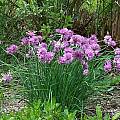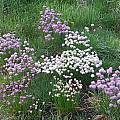On the legacy bulb wiki pages Kathleen Sayce reviews bulbs that outlast their gardeners, with some hints as to why. Suggestions came from PBS list members, review of world weed lists, USDA PLANTS National Database, Flora of North America, and some university databases. For more information consult Legacy Bulbs Index and Introduction.
Information about relevant Albuca through Amaryllis species can be found on this wiki page.
Information about other species is found on the pages linked below:
Anemone through Chionodoxa - Colchicum through Erythronium - Ficaria through Hyacinthus - Ipheion through Iris - Ixia through Lycoris - Merendera through Nerine - Ornithogalum through Sternbergia - Trillium through Zephyranthes
Albuca bracteata, syn. Ornithogalum caudatum, syn. Ornithogalum longibracteatum, false sea onion, is known from Arkansas. It is native to South Africa; WHZ 9-10.
Allium species: Edible onions and ornamental relatives occupy a deep and wide niche between food, ornamentals and obnoxious escapee thug plants. The genus is large, with 600-750 species; the true number of species varies widely among sources. Alliums occur naturally in temperate climates of the Northern Hemisphere, with a few exceptions. While the following includes notes on known states and provinces where plants have established (recorded in herbaria and/or mentioned by members), in most cases, more species are probably far more widely established than is realized. A few are pernicious garden thugs, including three-corner leek and wild garlic.
Generally in the food group:
Allium ampeloprasum, syn. Allium porrum, broadleaf wild leek, or elephant garlic, is Asian. It has naturalized in California, Texas, and southern states to the eastern seaboard and North East.
Allium cepa, garden onion, has escaped and established in about half the continental US states, east, west and in the middle, excepting some colder states.
Allium fistulosum, Welsh onion, has established in Illinois, and Alaska. Despite the common name, it originated in Asia, possibly in Siberia or China. It is widely used in Asian cuisine.
Allium neapolitanum, white garlic, has established in California, Louisiana, Florida and Georgia. It is native to southern Europe, North Africa and the Middle East, and is classified as an invasive species in some US states. It has large heads of pure white flowers, and is often grown as an ornamental.
Allium nigrum, black garlic, has established in Oregon and Washington
Allium oleraceum, field garlic, has established in Ontario, Canada, south to Virginia and Kentucky. It is native to temperate Eurasia, and produces seeds, bulblets in the seed head, and offset bulbs. It is found in dry grassy areas, such as sunny slopes.
Allium sativum, cultivated garlic, has established in most states and provinces of North America. Its place of origin is not known, due to a long history of cultivation and selection; it may have first appeared in Asia.
Allium schoenoprasum, chives, grows in most of the United States north of the southern belt, and is the only allium native to both Eurasia and North America. Chives have been cultivated in Europe for more than 5,000 years.
Allium triquetrum, threecorner leek, has established in Oregon and California, New Zealand, and Australia. It is a Mediterranean species, and spreads rapidly in disturbed areas. It is considered invasive in mild climates where it sets seed and spreads with ease.
Allium tuberosum, Chinese chives, has established in Midwest states of Wisconsin, Iowa and Kansas. It is native to China, and well known in Asian cuisine.
Allium vineale, wild garlic, has established in most provinces and states of North America, ranging from Alaska to Florida to Quebec. Native to Eurasia, it has been introduced to Australia and North America, where it rapidly became an invasive species. It often produces bulbils instead of flowers in its flower head, which aids its spread.
Generally in the ornamental group:
Allium bulgaricum, syn. Nectaroscordum siculum, Mediterranean Bells, Sicilian Honey Lily, Ornamental Onion or Sicilian Garlic, can grow in most of North America. It is native to France and Italy.
Allium caeruleum, blue globe onion, is from Asia.
Allium carinatum, keeled garlic, is considered invasive in Europe, and persists long past cultivation.
Allium cernuum, nodding onion, is widely native across North America, from New York and British Columbia south to Virginia and Kentucky, and south in the mountains. It establishes easily in gardens.
Allium moly, golden garlic or lily leek, is from Spain and southern France. It may occasionally be a pest, and often establishes easily in gardens.
Allium paradoxum, few-flowered leek, may have flowers replaced by bulbils; the bulbiferous form is considered a serious pest in the British Isles, where it invades woodlands and riverbanks. Originally from Iran, gardeners should look for the non-bulbiferous form.
Allium senescens, German garlic, or pink curly onion, is an ornamental onion with a tall head of flowers and twisted leaves.
Allium sphaerocephalon, round-headed leek or drumsticks, is grown for its striking tall, round flower head.
Amaryllis belladonna, belladonna lily, is a vigorous bulb of warmer climates. It is native to the Southwestern Cape in Africa, with a large brown bulb and moderate growth rate. Bulbs may take a few years to establish, and then persist for many decades provided their needs for winter water and summer heat are met. When this species was discussed on the PBS list, on the topic of fall rather than late summer flowering, comments from many parts of North America confirmed that it is very widely grown despite being hardy only in WHZ 7-10 (11) and not blooming in areas where it is unhappy. In colder climates, popular planting locations include under south-facing house eaves, to ensure bulbs get their needed dose of summer warmth and are protected from the coldest winter temperatures. Amaryllis belladonna can persist for decades in favorable locations, though it produces ripe seeds only in suitable warm-fall climates. In one location on the Pacific Northwest Coast, it was first planted around 1900 at a military base, and was still flowering, though crowded, a century later, in 2010. There are many naturalized populations in coastal areas of California and it is naturalized in Louisiana as well.
Species listed on other legacy bulb pages can be found alphabetically by clicking on the links below or by going to the index and introduction page where they will be listed in a table.
Anemone through Chionodoxa - Colchicum through Erythronium - Ficaria through Hyacinthus - Ipheion through Iris - Ixia through Lycoris - Merendera through Nerine - Ornithogalum through Sternbergia - Trillium through Zephyranthes - Legacy Bulbs Index and Introduction


























